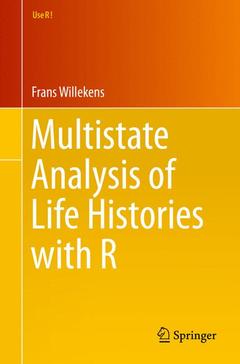Description
Multistate Analysis of Life Histories with R, 2014
Use R! Series
Language: English
Subjects for Multistate Analysis of Life Histories with R:
308 p. · 15.5x23.5 cm · Paperback
Description
/li>Contents
/li>Biography
/li>Comment
/li>
This book provides an introduction to multistate event history analysis. It is an extension of survival analysis, in which a single terminal event (endpoint) is considered and the time-to-event is studied. Multistate models focus on life histories or trajectories, conceptualized as sequences of states and sequences of transitions between states. Life histories are modeled as realizations of continuous-time Markov processes. The model parameters, transition rates, are estimated from data on event counts and populations at risk, using the statistical theory of counting processes.
The Comprehensive R Network Archive (CRAN) includes several packages for multistate modeling. This book is about Biograph. The package is designed to (a) enhance exploratory analysis of life histories and (b) make multistate modeling accessible. The package incorporates utilities that connect to several packages for multistate modeling, including survival, eha, Epi, mvna<, etm, mstate, msm, and TraMineR for sequence analysis. The book is a ?hands-on? presentation of Biograph and the packages listed. It is written from the perspective of the user. To help the user master the techniques and the software, a single data set is used to illustrate the methods and software. It is the subsample of the German Life History Survey, which was also used by Blossfeld and Rohwer in their popular textbook on event history modeling. Another
data set, the Netherlands Family and Fertility Survey, is used to illustrate how Biograph can assist in answering questions on life paths of cohorts and individuals.The book is suitable as a textbook for graduate courses on event history analysis and introductory courses on competing risks and multistate models. It may also be used as a self-study book. The R code used in the book is available online.
Frans Willekens is affiliated with the Max Planck Institute for Demographic Research (MPIDR) in Rostock, Germany. He is Emeritus Professor of Demography at the University of Groningen, a Honorary Fellow of the Netherlands Interdisciplinary Demographic Institute (NIDI) in the Hague, and a Research Associate of the International Institute for Applied Systems Analysis (IIASA), Laxenburg, Austria. He is a member of Royal Netherlands Academy of Arts and Sciences (KNAW). He has contributed to the modeling and simulation of life histories, mainly in the context of population forecasting.
Frans Willekens is affiliated with the Max Planck Institute for Demographic Research (MPIDR) in Rostock, Germany. He is Emeritus Professor of Demography at the University of Groningen, a Honorary Fellow of the Netherlands Interdisciplinary Demographic Institute (NIDI) in the Hague, and a Research Associate of the International Institute for Applied Systems Analysis (IIASA), Laxenburg, Austria. He is a member of Royal Netherlands Academy of Arts and Sciences (KNAW). He has contributed to the modeling and simulation of life histories, mainly in the context of population forecasting.
These books may interest you

Dynamical Biostatistical Models 129.87 €



